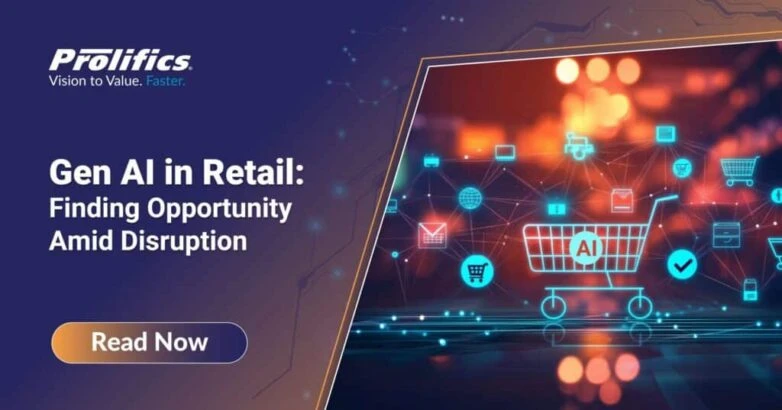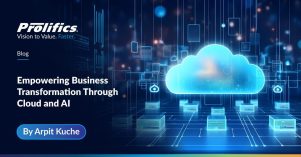Gen AI in Retail is revolutionizing the retail industry in ways we never imagined. As sustainability, technological advancements, and shifting consumer expectations reshape the market, retailers must stay ahead of the curve to avoid disruption.
Today’s consumers wield more influence than ever, demanding transparency, personalization, and even the co-creation of products and services. However, while customer empowerment is key, brands must strike a balance—ensuring engagement without losing control of their narrative. By focusing on the core pillars of empathy—seeing, hearing, thinking, feeling, saying, and doing—retailers can craft meaningful and highly personalized shopping experiences.
At the forefront of this transformation, Gen AI in Retail enables global retailers to tailor experiences individually, redefining customer engagement and driving innovation across the retail and consumer goods sectors.
IDC FutureScape: Worldwide Retail 2025 Predictions
Recent study by the IDC FutureScape: Worldwide Retail 2025 Predictions highlights the increasing role of Gen AI in Retail:
- Prediction 1: By 2026, 90% of retail tools will embed AI algorithms, with over 30% of these algorithms using standalone AI or modular, agnostic AI models that can be swapped out for suitable retail-specific models.
- Prediction 2: By 2028, 30% of retailers will drive 10% IT costs out of stores by utilizing distributed edge with onboard AI chips, reducing latency and improving IT operations performance.
- Prediction 3: By 2026, 70% of retailers will implement AI-driven loyalty apps, improving contextualized offers by 40% and boosting customer engagement to drive up to a 25% increase in customer retention rates.
- Prediction 4: By 2028, secondary inventory management benefits realized from technology adopted to be compliant with regulations will spur a 30% increase in supply chain adoption of track and trace capabilities.
- Prediction 5: By 2025, major retailers will boost IT spending by 10%+ to enhance cybersecurity to better battle the rising tide of new, more sophisticated data breaches and other cyberthreats retailers now face.
- Prediction 6: By 2027, 40% of retailers will leverage Gen AI in Retail for content creation and delivery for dynamic product content, boosting conversion rates and cutting content management costs by 30%.
- Prediction 7: By 2026, 50% of retailers will have reduced workforce costs by 2% with embedded Gen AI in Retail in fundamental business processes and tasks across business operations at corporate and in stores.
- Prediction 8: By 2027, over 45% of major retailers will apply hyper-localization for store-specific assortment planning, selection, allocation, and replenishment that leverages AI and data-driven decision-making.
- Prediction 9: By 2029, grocery retailers will harness quality data at scale from interoperable unified supply networks for AI-based decision intelligence to see a 6% increase in profits and 18% reduction in waste.
- Prediction 10: By 2026, 70% of major retailers will invest in loss prevention tech applying AI to integrated data sets with multiple sources (RFID, camera, traffic, and inventory data) to reduce in-store theft by 25%.
Common Gen AI in Retail Use Cases
1. Product Development
AI accelerates product ideation and design by analyzing market trends, consumer preferences, and competitor insights. Gen AI in Retail enables brands to create virtual prototypes, predict product success, and tailor offerings to evolving demands.
2. Inventory Management
Retailers can leverage AI-driven forecasting to optimize stock levels, prevent overstocking or shortages, and reduce operational costs. Automated insights help businesses maintain the right balance between supply and demand.
3. Customer Service
Chatbots and AI-driven virtual assistants provide 24/7 support, reducing response times and enhancing customer satisfaction. Gen AI in Retail can handle inquiries, process returns, and personalize interactions based on past behavior.
4. Price Optimization
Retailers can use AI-powered pricing models to analyze competitor pricing, consumer demand, and external factors like economic shifts, ensuring dynamic and competitive pricing strategies.
5. Visual Merchandising
Gen AI in Retail tools create optimized store layouts and digital experiences, predicting which displays and product placements will drive the most engagement and conversions.
6. Content Creation
Retailers can leverage AI-generated content, from product descriptions to social media ads, ensuring consistent, high-quality messaging while saving time and resources.
7. Personalized Marketing
AI-driven personalization tailors promotions, recommendations, and campaigns to individual consumer behaviors, increasing engagement and driving conversions.
8. Market Demand and Forecasting
By analyzing vast data sets, Gen AI predicts consumer trends, seasonal fluctuations, and market shifts, allowing retailers to make data-driven business decisions.
How Gen AI is Changing Retail and Consumer Goods
Speeding Product Development
By automating ideation, prototyping, and testing, retailers can bring products to market faster. AI-driven insights eliminate guesswork and refine offerings before launch.
Creating High-Value Experiences
From AI-powered styling assistants to immersive virtual shopping experiences, retailers are using Gen AI to deliver unique, value-driven consumer interactions.
Optimizing Supply Chain Operations
AI streamlines logistics by predicting disruptions, automating procurement, and ensuring optimal warehouse management, resulting in a more resilient supply chain.
Automating Procurement
Retailers can leverage AI-driven procurement solutions to optimize sourcing, reduce costs, and ensure the timely acquisition of high-demand products.
Redefining Customer Service
Beyond chatbots, AI enables sentiment analysis, predictive customer support, and hyper-personalized recommendations, enhancing customer loyalty and retention.
Best Practices for Gen AI in Retail
Engage and Inform Employees – AI adoption isn’t just about technology—it’s about people. Training employees to work alongside AI fosters collaboration and maximizes efficiency.
Innovate, Don’t Stagnate – Retailers must continuously experiment with AI-driven solutions to stay ahead of the competition. Embracing innovation ensures long-term relevance.
Build Confidence with Transparency – Consumers value ethical AI. Retailers should be transparent about AI-driven personalization and decision-making, ensuring trust and compliance.
Meet the Needs of AI-Enabled Consumers – Today’s shoppers expect hyper-personalized, seamless experiences. Retailers must align AI strategies with evolving consumer expectations to drive loyalty and engagement.
Conclusion
Gen AI is revolutionizing retail, offering unprecedented opportunities for innovation, efficiency, and customer engagement. Retailers that embrace AI-driven transformation will not only stay competitive but thrive in an increasingly digital world. By leveraging AI for product development, personalized marketing, supply chain optimization, and customer service, businesses can create a future-ready retail ecosystem that meets the needs of modern consumers.
Transform customer experiences, optimize supply chains, and drive sales with AI-powered automation. Discover how Prolifics helps retailers harness Generative AI for smarter decision-making and personalized engagement.




